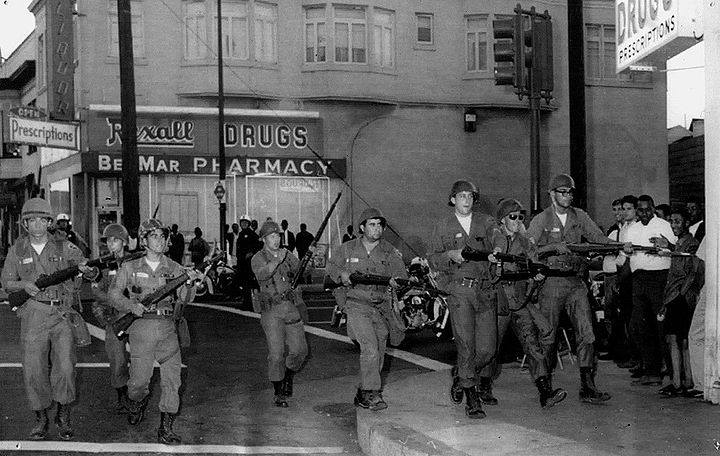
07 Jun READY…SET…BURN PART ONE
The Story of the Trial of the LAPD Officers Who Beat Rodney King, and the Flames That Engulfed Los Angeles
“Television used the tape like wallpaper.”
–Ed Turner, Vice President of CNN
George Holliday was asleep in his in his suburban Lakeview Terrace apartment when the squeal of police sirens jolted him to consciousness. It was just about 1 A.M. in the morning of March 3rd, 1991. The thirty-one-year-old owner of a small plumbing company swept his feet from under his comforter and onto the floor as the drumming bleat of helicopter blades, beating against the humid Los Angeles air, began to harmonize with the screaming sirens. He rushed to his window and peered down to see a large black man surrounded by uniformed officers holding weapons and shouting.
He turned back away from the window and retrieved his newly purchased Sony camcorder from its original packaging. “Something happens between the weddings and the birthday parties-it’s called the rest of your life,” Sony’s commercial for its latest handheld camera, the Handycam, had proclaimed. What George Holliday was about to record with his Handycam certainly wasn’t a wedding or a birthday, but it would become one of the most seen moments of “American Life” ever recorded.
RODNEY KING
Rodney Glen King, known to his friends as Glen, drank too much. As a result of his alcoholism he had found himself a foul of the law different occasions. In 1987 his wife accused him of attacking her as she lay asleep, and beating her. He was convicted and ordered to attend counseling, which he never did. In 1989 he attempted to rob a convenience store with a tire iron. When the clerk grabbed the iron in King’s hand he stumbled backward onto a pie rack. He was convicted, imprisoned, and paroled in December of 1990.
King held down steady employment in the construction industry, he was fondest of working on skyscrapers. He found the heights thrilling and reveled in the thought that he had a hand in creating something so grand in scale. On the day of his infamous arrest he was working on a project at Dodger Stadium. But it was when he wasn’t working that he was most susceptible to the demons of his addiction.
On the evening of March 2, 1991, King was at friend’s home watching a basketball game and drinking forty-ounce bottles of Olde English 800. After the game he wanted to take a trip and asked two of the party-goers to join him, and “look for some girls”. King, Pooh Allen, and Freddie Helms left with King behind the wheel.
THE ARREST
At 12:30 A.M. the husband and wife team of California Highway Patrol officers, Tim and Melanie Singer, spotted King’s Hyundai driving behind them at very high speed. Tim Singer exited then returned to the freeway and activated the unit’s lights. The Hyundai only increased its speed. The Singers’ unit reached speeds of up to 117 MPH during the pursuit. At one-point King left via an exit ramp sped through a red light nearly causing an accident, before finally coming to a stop near the entrance of Hansen Dam Park, right outside of George Holliday’s balcony apartment window. Within seconds three Los Angeles police cars and a police helicopter arrived on scene.
Tim Singer, his duty weapon drawn, ordered the occupants out of the vehicle, Allen and Helms complied, King remained inside the Hyundai. Melanie Singer now shouted at King to exit the vehicle, which he did. According to Melanie Singer, King was smiling and appeared to be waiving at the police helicopter overhead. When she ordered him to get his hands up, he appeared to grab his right buttock with his right hand and shake it at her. King finally complied and went to the ground. As Melanie Singer approached, with her gun aimed at the prone King, LAPD Sergeant Stacy Koon shouted, “Stand back. Stand back. We’ll handle this.”
LAPD officers Lawrence Powell and Timothy Wind had arrived in one police car, Theodore Briseno and Rolando Solano in another, and Stacy Koon in a third. After telling the Singers to stand back, Koon and the other LAPD officers began to surround King, and Koon deployed his Taser. King seemed unfazed by the electrifying darts and began to rise. Ninety feet away George Holliday pressed record on his new Handycam.
THE BEATING
King rose to feet and began to advance in the direction of Officer Powell. The recording of the event came into focus as Officers Powell and Wind began to strike King with their metal batons. King goes to the ground.
For the next minute and a half, Officers Wind and Powell deliver over fifty baton blows and several kicks. Sergeant Koon appears to direct the flailing King as the baton strikes land over all parts of his body and he rolls into defensive positions. At one-point Officer Briseno is seen stomping on King’s shoulder causing his head to strike the pavement violently. One or more of the baton strikes land to King’s head. The violence that occurs is too far away for the Handycam’s microphone to pick up the sound of King saying, “Please Stop.”
King is handcuffed and taken to Pacifica Hospital. Koon, the ranking officer on scene, asks those that participated in the use of force to raise their hands. He enters the following message into his in-car computer: “U just had a big time use of force. Tased and beat the suspect of CHP pursuit.” Powell would go on to type more messages into his computer that would later add to the controversial arrest, and those coupled with other messages, typed by other participating officers would lead to a revelation long thought to exist by the minority community in Los Angeles.
DEMANDS FOR JUSTICE
George Holliday knew he had witnessed and recorded something important. The following day, March 4th, he would enter the offices of KTLA and give his film over. The news producers found his tape shocking and played it on that evening’s news. The following day CNN picked up the tape and ran it, soon it was everywhere and Americans from California to Maine watched the beating of Rodney King from their living room television sets.
The outcry from the public was not only fast, it was nearly unanimous. A poll taken in Los Angeles after the tape had been running showed that 92% of those polled believed that excessive force was used against Rodney King. Those feelings seemed to extend even too many within the LAPD itself. Police Chief Daryl Gates called the use of force “very, very extreme”: “For the LAPD, considered by many the finest, most professional police department in the world, it was more than extreme. It was impossible.”
On March 7th, Chief Gates announced the officers involved would be prosecuted. The matters were taken to a grand jury. The grand jury watched the video tape, heard testimony and returned indictments against Officers Koon, Powell, Briseno, and Wind.
At first the King beating was not seen as a “racial matter”. However, as prosecutors began to develop a case and collect evidence against the officers for trial, the ugly backdrop of racism began to unfurl. Messages from the involved officers’ in-car computers would reveal a dark undertone and prompted Los Angeles Mayor Tom Bradley to declare, “There appears to be a dangerous trend of racially motivated incidents running through at least some segments of the Police Department.” Bradley would appoint future Secretary of State Warren Christopher, to investigate LAPD practices and procedures and make recommendations for reform. The City was soaked in gasoline; the beating of Rodney King was a match; the upcoming trial would cause that match to fall; and Los Angeles would go up in flames.
SOAKED IN GASOLINE
The LAPD has a long history with the African American community within its jurisdiction. Although California was never associated with regulations on minorities in the same vein as the Jim Crow South, there is a history of segregation. Segregation in Los Angeles appeared more in form of spoken and unspoken geographical boundaries and customs. Blacks were relegated to certain neighborhoods through restrictive covenants which prevented minorities from purchasing or renting homes and other real estate in certain areas of the city. As Los Angeles began to grow, forms of policing were used to keep the blacks and other minorities from wondering from their turf. In 1950 William H. Parker was named as police chief for the City of Los Angeles and he would retain that position until 1966.
Parker was a military man, and he sought to urbanize the police force from its more western style approach. He would recruit former military to serve in his police force, and deployed units and patrols in mass to demonstrate an active and present show of force. The City’s use of covenants and regulations for the lease and purchase of property forced minorities to gather in certain sections of town. This lead to geographical boundaries which the Parker era enforced through police stops. If a black person found them self “on the wrong side of town” they could expect to be stopped by police, questioned and possibly detained or arrested for a minor offense.
Over the years there would be marches and even riots. On August 11, 1965 the neighborhood of Watts broke out into violence after an altercation between a black man and a police officer during a traffic stop. Six days of looting followed, 4,000 National Guardsmen were brought in to contain the rioters, and 34 people lost their lives. But the damage was more less contained to the predominantly black, Watts neighborhood.
Parker and those that followed would employ a strong show of force and surround the minority neighborhoods, limiting the potential damage and influence from such uprisings from creeping into the white areas of town that attracted tourists and promoted California glamour.
As Los Angeles changed throughout the decades it appeared that the attitudes of many of the LAPD did not. The following was recovered from the in-car computer messaging systems of the officers involved in the Rodney King beating:
***The transcript of transmissions between squad cars and the watch commander’s office of the Los Angeles Police Department’s Foothill Division in the early morning of March 3:
12:29 a.m. From unidentified foot patrol officers in Sunland-Tujunga to Officers Laurence M. Powell and Timothy Wind: “What are you up to….We are up on the rock with [cars] L170, 82 and A89 on top of some abandon house with narco and BFMV [burglary from motor vehicle] suspects in it ….We are waiting for them to hit some places.”
12:31 a.m. From Powell to the foot patrol officers: “….Sounds almost exciting as our last call….It was right out of Gorillas in the Mist.”
12:32 a.m. From the foot patrol officers to Powell and Wind: “….HaHaHaHa….let me guess who be the parties.”
12:32 a.m. From Powell and Wind to the foot patrol officers: “….I’m just trying to get through the night cause then I’m off for six, count them six, days….time for some serious bike riding.”
12:32 a.m. From Powell and Wind to the foot patrol officers: “….Good guess.”
12:34 a.m. From the foot patrol officers to Powell and Wind: “….You can’t even get out of bed in the morning let alone bike ride….I’ll believe that when I see it….I have one more then I’m off for four.”
12:36 a.m. From Powell and Wind to the foot patrol officers: “….That’s where your wrong….I was up at 12:30 today….I can’t sleep that’s the problem….I need to get worn out.”
12:43 a.m. From the foot patrol officer to Powell and Wind: “….But can you keep up….HaHaHaHa….People better know we are talking about bicycling and not something else or they will begin to wonder what these messages are about HaHaHaHa.”
12:45 a.m. From Powell and Wind to the foot patrol officer: “Oh bicycling….Of course.”
12:47 a.m. From emergency board operator to all units: “CHP [California Highway Patrol] advises their officers are in pursuit of a vehicle failing to yield southbound Paxton- Foothill….Vehicle is white Hyundai, license 2KFM102, now approaching Glenoaks….Vehicle is now southbound Glenoaks- Paxton….now passing Sylmar….Vehicle is now northbound Van Nuys-Bordon….Foothill RTO [radio-telephone operator] is taking over the broadcasting of the pursuit [car] 16A23 [Powell and Wind] is the primary unit….Now eastbound Van nuys at Fulton…stopped at a light southbound Van Nuys at Foothill…two male black occupants…Vehicle still refusing to yield now eastbound Foothill at Osborne…”
Powell and Wind then got out of their car to investigate on Foothill east of Osborne. One of them broadcast a Code 4, meaning sufficient units were on scene and suspects were in custody at 12:59.
12:56 a.m. From Sgt. Stacy C. Koon to Foothill watch commander’s office: “…You just had a big time use of force…tased and beat the suspect of CHP pursuit, Big Time.”
12:57 a.m. From watch commander’s office to Koon: “Oh well…I’m sure the lizard didn’t deserve it….HaHa. I’ll let them know O.K.”
1:11 a.m. From Koon to watch commander’s office: “….I’m gonna drop by the station for a fresh taser and darts…please have desk have one ready.”
1:11 a.m. From watch commander’s office to Koon: “Okey doke on the ACC desk….You want extra darts??? It’s got two.”
1:12 a.m. From Powell and Wind to the foot patrol officer: “….ooops.”
1:12 a.m. From the foot patrol to Powell and Wind: “oops, what?”
1:13 a.m. From Powell and Wind to the foot patrol: “I haven’t beaten anyone this bad in a long time.”
1:15 a.m. From the foot patrol to Powell and Winds: “Oh not again….Why for you do that….I thought you agreed to chill out for awhile….What did he do?”
1:16 a.m. From Powell and Wind to the foot patrol: “I think he was dusted…many broken bones later….After the pursuit….”
1:17 a.m. From the foot patrol to Powell and Wind: “What pursuit?”
TO BE CONTINUED…







No Comments